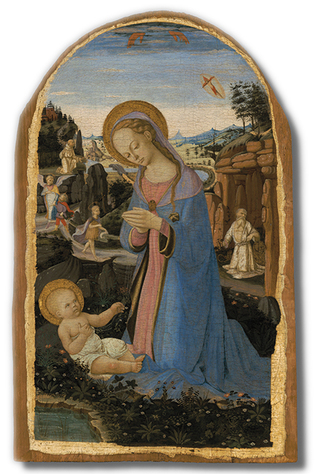 loading
loading
Arts & CultureGroup effortObject lesson: the work of a master, restored. Laurence Kanter is chief curator and the Lionel Goldfrank III Curator of European Art at the Yale University Art Gallery.  University purchase from James Jackson JarvesWho created this fifteenth-century Italian work, painted in tempera on a panel? Many have speculated over the years. Recently, the main figures were carefully restored, and it now appears that two artists collaborated on it. View full imageThis poetic image of the Virgin Mary adoring her infant son as he lies in a meadow of grasses and wildflowers is one of a large group of pictures, identical in subject and similar in composition, that appeared in Florence during the second half of the fifteenth century. Featured in the Yale University Art Gallery’s recent exhibition, Leonardo: Discoveries from Verrocchio’s Studio, it must be esteemed among the very highest in quality within this group, although it has never been clear whether it appeared at the beginning of the series, sparking a great number of admiring imitations, or nearer to the middle or end, perfecting the example set by a still-unidentified model. The composition in its broadest outlines draws from a small altarpiece by Fra Filippo Lippi, now in Berlin, that was painted around 1460 for the private chapel of the Medici family in their palazzo on the Via Larga (now the Via Cavour) in Florence. The Yale painting, as do most of the later “replicas,” substitutes a more naturalistic view of the Arno Valley for the fantastic and exotically colored grotto landscape Fra Filippo included in the background of his Adoration. The Yale painting also includes, scattered across its background, small vignettes of Saint Francis receiving the stigmata, the Archangel Raphael walking with Tobias, and the penitent Saint Jerome and the young Saint John the Baptist in the wilderness. These vignettes no doubt refer either to the name saints of the painting’s original owner and his family (we can assume he was male, as all the saints are male) or, given their great number, to the dedications of a religious confraternity to which he belonged. Part of the Art Gallery’s collection for nearly a century and a half, the Adoration of the Christ Child has been the subject of numerous attributions over the years. Most recently, senior scholars in the field have ascribed it to one or another of two painters who are thought to have been the principal assistants of the great goldsmith, painter, and sculptor Andrea del Verrocchio (1435–1488) in the years before Leonardo da Vinci replaced them as Verrocchio’s chief apprentice. The painters in question, Jacopo del Sellaio (ca. 1441–1493) and Biagio d’Antonio (1444/46–1516), had both left Verrocchio’s employ to embark on independent careers by 1470. Each collaborated frequently with other painters after they left, and they briefly formed a partnership in 1472, so distinctions between their respective painting styles are not always straightforward. Both artists are chiefly remembered for the large number of commercial and decorative paintings that emerged from their workshops, in which they recycled, with little variation, drawings for figures that they may have inherited from their time in Verrocchio’s studio. This free exchange of working materials between Verrocchio and his pupils has led to a great deal of confusion in identifying Verrocchio’s own painting style, since he seems throughout his career to have relied upon (or taken advantage of) the work of collaborators. It now seems possible to recognize the Yale Adoration not as an imitation of Verrocchio’s early style by either Jacopo or Biagio, as had previously been thought, but rather as a joint effort by Verrocchio himself and Biagio. Verrocchio appears to have been responsible for the design of this influential composition and for painting the principal figures of the mother and her son; they were severely damaged in the nineteenth century or earlier and were recently carefully restored. Biagio painted the much better-preserved landscape and possibly some parts of the background figures at the left, as well as the hands of God the Father at the top. Dating the picture is a matter of conjecture, but it is probably to be assigned to the mid-1460s, shortly before Biagio left Verrocchio’s workshop. Certainly it was painted before the arrival there of the young Leonardo da Vinci. He would soon come to exercise as much of an influence on his teacher’s style as his teacher, Verrocchio, exercised on him.
The comment period has expired.
|
|